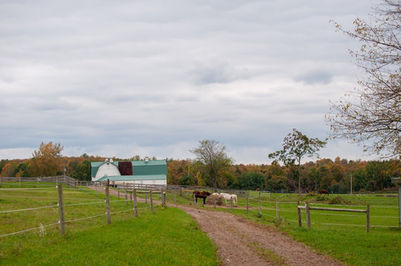History of Cracker Box Palace
Cracker Box Palace has, in a sense, been helping sick and abused animals since the early 1990s, before it was formally designated a nonprofit and moved onto Alasa Farms.
It began on the day Walt Roloson was called on to help a group of Saddlebred horses. Roloson, a lifelong lover and trainer of horses, had been working for over 50 years with green and troubled horses.
On that day, Walt came across a difficult situation. An owner could no longer properly care for his horses, and Walt saw that they were in danger. Working with his daughter Cheri and her husband Burt Madison, he was able to secure possession of the horses and to take them into his care.
One of the horses who ended up going home that day made an indelible impression on Cheri and Burt. Melvin, a tall and gangly colt with deep copper red color and a white stripe down his face, had funny curved-in ears that gave him a sassy appearance that suited his spirited personality.
Initially, Melvin was so weak that Walt had to trim his hooves while he was lying down. Cheri, in particular, became devoted to Melvin. After several years of commitment and perseverance, Melvin was back in good health and high spirits.

Melvin’s arrival marked the effective beginning of Cracker Box Palace.
The informal shelter was first situated on a somewhat dilapidated migrant camp. The old buildings housing Melvin were the "cracker box" part of the shelter's name. Cheri borrowed the phrase "Cracker Box Palace" from a George Harrison song, recognizing the connection between the cracker boxes where the animals lived and the fact that for Melvin, the shelter was nonetheless a kind of palace - a place where, as she put it, "the animals rule".
Over time Cheri and Burt realized Wayne County needed a shelter for not only abused and neglected horses but for all kinds of farm animals. Cracker Box Palace grew by meeting that real need.
In spring 2001, Cracker Box Palace officially opened as a nonprofit shelter. The list of residents had expanded from horses to include geese, ducks, chickens, peacocks, rabbits, goats, sheep, alpaca, llama, pigs, donkeys and cows.
.jpeg)
By 2003, Cracker Box Palace found itself unable to construct facilities quickly enough to accommodate all the animals in need of homes, so Burt and Cheri looked to Griff Mangan, a long-time friend and supporter. Mangan’s family owned Alasa Farms, with three big, 100-year0old barns, several outbuildings, fields, orchards, and 300 acres of woods with plenty of room for stalls, pens, trails and pastures. It was a perfect place for the expansion of Cracker Box Palace.
Over time, many animals have enjoyed brief stays here, making new friends and receiving veterinary care before going on to new homes. Others either remain eligible for adoption or retire to the farm to live out their lives in safety and comfort under the care of our staff and volunteers.
Around ten years ago, the private owners decided to sell the farm. Instead of selling to a developer, Griff and his family chose to preserve the farm for its current purpose in perpetuity. In 2011, the local community, the conservation groups and the state all worked together to raise the funds needed to transfer the entire farm to the "little animal shelter that could," - Cracker Box Palace.

There is much to see, do and learn at Alasa Farms, but the beating heart of the place is, and always will be, Cracker Box Palace.
-03.png)













